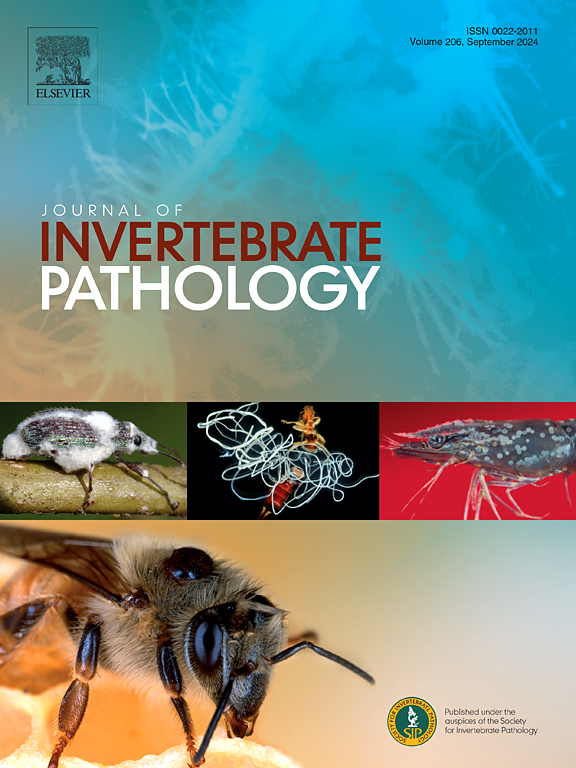The unique transmembrane protein NbTMP2 (NBO_555g0004) of Nosema bombycis contributes to host infection
IF 2.4
3区 生物学
Q1 ZOOLOGY
引用次数: 0
Abstract
Nosema bombycis is one of the earliest discovered microsporidia and can infect silkworms through both horizontal and transovarial transmission, posing a significant threat to the sericulture industry. Microsporidia can form mature dormant spores with a thick proteinaceous and chitin-rich wall that shields them from environmental stress, leading to difficulties in prevention and control. However, the intracellular proliferative phase is a particularly active life stage for the pathogen. At this stage, the plasma membrane of pathogen is exposed to the cytoplasm of the host cells without the protection of the spore walls, which make it an ideal phase for intervention. In this study, based on transcriptomic data, we identified that a transmembrane protein of N. bombycis, NbTMP2 (NBO_555g0004), was highly expressed after infection with microsporidia. Sequence analysis of the cloned NbTMP2 gene revealed that the protein consists of 253 amino acids, including a signal peptide and a transmembrane domain. Indirect immunofluorescence analysis (IFA) showed that NbTMP2 is localized to the plasma membrane. Furthermore, IFA, RT-qPCR, and western blotting indicated that NbTMP2 is expressed at all developmental stages, with a significant upregulation during the early proliferative phase of N. bombycis. The interference of NbTMP2 confirmed that downregulation of NbTMP2 expression significantly inhibit the proliferation of N. bombycis. In conclusion, NbTMP2 is a membrane protein that plays a role during the development of N. bombycis. This study provides a potential target for inhibiting the proliferation of N. bombycis and lays a foundation for future research on breeding N. bombycis-resistant silkworms.

bombycis小孢子虫独特的跨膜蛋白NbTMP2 (NBO_555g0004)参与宿主感染。
家蚕微孢子虫(Nosema bombycis)是最早发现的微孢子虫之一,可通过水平传播和经卵巢传播感染家蚕,对蚕桑产业构成重大威胁。小孢子虫可以形成成熟的休眠孢子,孢子壁具有厚厚的蛋白质和富含几丁质,使其免受环境胁迫,这给防治带来了困难。然而,细胞内增殖期是病原体特别活跃的生命阶段。在这个阶段,病原体的质膜暴露在宿主细胞的细胞质中,没有孢子壁的保护,这是一个理想的干预阶段。在本研究中,基于转录组学数据,我们发现了一种跨膜蛋白NbTMP2 (NBO_555g0004)在感染微孢子虫后高表达。克隆的NbTMP2基因序列分析显示,该蛋白由253个氨基酸组成,包括一个信号肽和一个跨膜结构域。间接免疫荧光分析(IFA)显示NbTMP2定位于质膜。此外,IFA、RT-qPCR和western blotting结果表明,NbTMP2在家蚕的所有发育阶段均有表达,并在增殖早期显著上调。NbTMP2的干扰证实,下调NbTMP2的表达可显著抑制家蚕的增殖。综上所述,NbTMP2是一种在家蚕发育过程中起作用的膜蛋白。本研究为抑制家蚕增殖提供了潜在靶点,为今后家蚕抗家蚕育种研究奠定了基础。
本文章由计算机程序翻译,如有差异,请以英文原文为准。
求助全文
约1分钟内获得全文
求助全文
来源期刊
CiteScore
6.10
自引率
5.90%
发文量
94
审稿时长
1 months
期刊介绍:
The Journal of Invertebrate Pathology presents original research articles and notes on the induction and pathogenesis of diseases of invertebrates, including the suppression of diseases in beneficial species, and the use of diseases in controlling undesirable species. In addition, the journal publishes the results of physiological, morphological, genetic, immunological and ecological studies as related to the etiologic agents of diseases of invertebrates.
The Journal of Invertebrate Pathology is the adopted journal of the Society for Invertebrate Pathology, and is available to SIP members at a special reduced price.

 求助内容:
求助内容: 应助结果提醒方式:
应助结果提醒方式:


